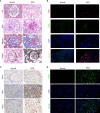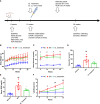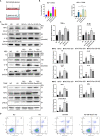Excessive Activation of Notch Signaling in Macrophages Promote Kidney Inflammation, Fibrosis, and Necroptosis
- PMID: 35280997
- PMCID: PMC8913942
- DOI: 10.3389/fimmu.2022.835879
Excessive Activation of Notch Signaling in Macrophages Promote Kidney Inflammation, Fibrosis, and Necroptosis
Abstract
Diabetic nephropathy (DN) is one of the main causes of end-stage renal disease (ESRD). Existing treatments cannot control the progression of diabetic nephropathy very well. In diabetic nephropathy, Many monocytes and macrophages infiltrate kidney tissue. However, the role of these cells in the pathogenesis of diabetic nephropathy has not been fully elucidated. In this study, we analyzed patient kidney biopsy specimens, diabetic nephropathy model animals. Meanwhile, we cocultured cells and found that in diabetic nephropathy, damaged intrinsic renal cells (glomerular mesangial cells and renal tubular epithelial cells) recruited monocytes/macrophages to the area of tissue damage to defend against and clear cell damage. This process often involved the activation of different types of macrophages. Interestingly, the infiltrating macrophages were mainly M1 (CD68+iNOS+) macrophages. In diabetic nephropathy, crosstalk between the Notch pathway and NF-κB signaling in macrophages contributed to the polarization of macrophages. Hyperpolarized macrophages secreted large amounts of inflammatory cytokines and exacerbated the inflammatory response, extracellular matrix secretion, fibrosis, and necroptosis of intrinsic kidney cells. Additionally, macrophage depletion therapy with clodronate liposomes and inhibition of the Notch pathway in macrophages alleviated the pathological changes in kidney cells. This study provides new information regarding diabetic nephropathy-related renal inflammation, the causes of macrophage polarization, and therapeutic targets for diabetic nephropathy.
Keywords: NF-κB; Notch; diabetic kidney disease; diabetic nephropathy; kidney inflammation; macrophages; necroptosis; renal fibrosis.
Copyright © 2022 Ma, Li, Zhu, Yu, Liu, Zhang, Chen, Du, Chen, Chen, Xu and Fan.
Conflict of interest statement
The authors declare that the research was conducted in the absence of any commercial or financial relationships that could be construed as a potential conflict of interest.
Figures









Similar articles
-
Astragalus mongholicus Bunge and Panax notoginseng formula (A&P) improves renal mesangial cell damage in diabetic nephropathy by inhibiting the inflammatory response of infiltrated macrophages.BMC Complement Med Ther. 2022 Jan 20;22(1):17. doi: 10.1186/s12906-021-03477-x. BMC Complement Med Ther. 2022. PMID: 35057768 Free PMC article.
-
Mannose-binding lectin activates the nuclear factor-κB and renal inflammation in the progression of diabetic nephropathy.FASEB J. 2022 Mar;36(3):e22227. doi: 10.1096/fj.202101852R. FASEB J. 2022. PMID: 35195918
-
Requirement for TLR2 in the development of albuminuria, inflammation and fibrosis in experimental diabetic nephropathy.Int J Clin Exp Pathol. 2014 Jan 15;7(2):481-95. eCollection 2014. Int J Clin Exp Pathol. 2014. PMID: 24551269 Free PMC article.
-
Macrophage Phenotype and Fibrosis in Diabetic Nephropathy.Int J Mol Sci. 2020 Apr 17;21(8):2806. doi: 10.3390/ijms21082806. Int J Mol Sci. 2020. PMID: 32316547 Free PMC article. Review.
-
A Glimpse of the Mechanisms Related to Renal Fibrosis in Diabetic Nephropathy.Adv Exp Med Biol. 2019;1165:49-79. doi: 10.1007/978-981-13-8871-2_4. Adv Exp Med Biol. 2019. PMID: 31399961 Review.
Cited by
-
NSUN2 knockdown inhibits macrophage infiltration in diabetic nephropathy via reducing N5-methylcytosine methylation of SOCS1.Int Urol Nephrol. 2025 Feb;57(2):643-653. doi: 10.1007/s11255-024-04214-2. Epub 2024 Oct 9. Int Urol Nephrol. 2025. PMID: 39382603
-
Inflammation-Induced Klotho Deficiency: A Possible Key Driver of Chronic Kidney Disease Progression.Int J Gen Med. 2025 May 11;18:2507-2520. doi: 10.2147/IJGM.S513497. eCollection 2025. Int J Gen Med. 2025. PMID: 40376197 Free PMC article. Review.
-
Macrophages in Renal Injury, Repair, Fibrosis Following Acute Kidney Injury and Targeted Therapy.Front Immunol. 2022 Jul 13;13:934299. doi: 10.3389/fimmu.2022.934299. eCollection 2022. Front Immunol. 2022. PMID: 35911736 Free PMC article.
-
Relationship between Macrophages and Tissue Microenvironments in Diabetic Kidneys.Biomedicines. 2023 Jul 3;11(7):1889. doi: 10.3390/biomedicines11071889. Biomedicines. 2023. PMID: 37509528 Free PMC article. Review.
-
The Role of Immune Cells in DKD: Mechanisms and Targeted Therapies.J Inflamm Res. 2024 Apr 6;17:2103-2118. doi: 10.2147/JIR.S457526. eCollection 2024. J Inflamm Res. 2024. PMID: 38601771 Free PMC article. Review.
References
-
- International Diabetes Federation (IDF) . IDF Diabetes Atlas. 9th ed. Brussels, Belgium: International Diabetes Federation; (2019).
-
- United States Renal Data System . 2020 USRDS Annual Data Report: Epidemiology of Kidney Disease in the United States. Bethesda, MD: National Institutes of Health, National Institute of Diabetes and Digestive and Kidney Diseases; (2020).
Publication types
MeSH terms
LinkOut - more resources
Full Text Sources
Medical

